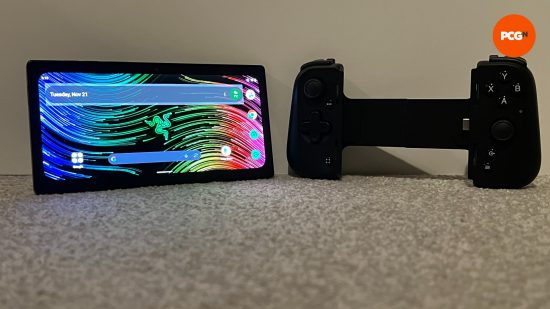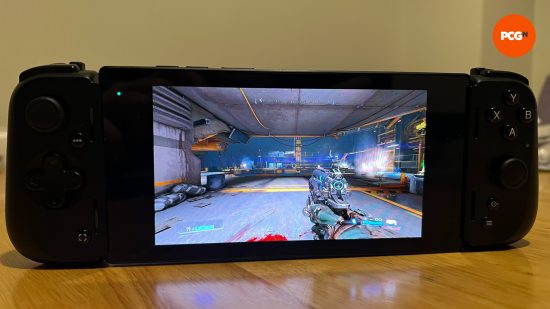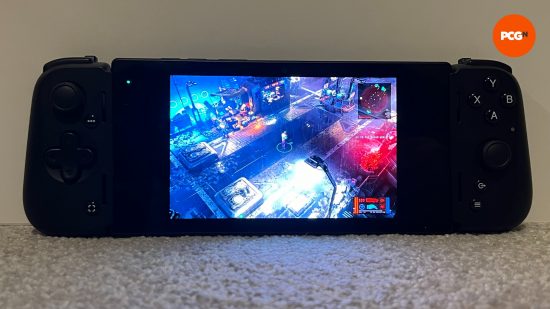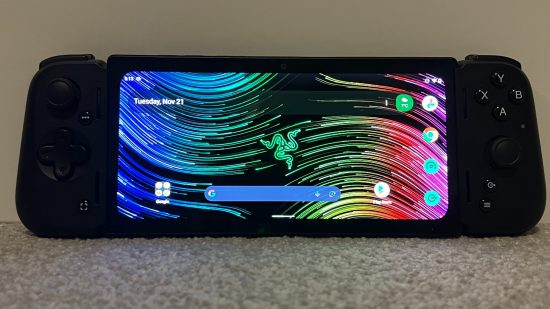Our Verdict
The Razer Edge is the best device that merges cloud and mobile gaming, with everything you need in the box to set you on your journey. There is potential for more in the future with updates or a revised model, but right now the Edge is a great console that i'm enjoying using every day.
- Brilliant OLED screen
- Cloud gaming capabilities
- Nexus software is revolutionary
- Battery life could be better
- Kairi grip takes some getting used to
The Razer Edge isn’t a traditional PC gaming handheld, and it could easily be argued that it isn’t one at all, but this mobile powerhouse is one of the best ways to play your games on the go. Using a powerful Android tablet, the Razer Kishi Pro V2, and some special software called Nexus, the Razer Edge mixes PC and mobile gaming in a way few other devices can.
While its status as a PC gaming handheld is debatable, the Razer Edge lets you play your PC games in various ways, all of which are super simple. Between that and the mobile capabilities, you could have a huge library of games waiting to be played the second you buy one. I initially found the Razer Edge to be a product with a blurry target market, but the more I used it, the more confident I am that the market is incredibly straightforward. It’s all gamers.
Why you can trust our advice ✔ At PCGamesN, our experts spend hours testing hardware and reviewing games and VPNs. We share honest, unbiased opinions to help you buy the best. Find out how we test.
| Processor | Snapdragon GX3 Gen 1 |
| Display | 6.4 inch FHD+ AMOLED, 144Hz |
| RAM | 6GB LPDDR5 |
| Storage | 128GB – Expandable up to 2TB |
| Battery | 5,000mAh |
| Available in | Wi-Fi & 4G models |

Razer Edge features
Razer knows how to sell you its products based on features, and the Edge is no different. Included in the box are the Razer Kishi V2 Pro and the Razer Edge tablet. The Edge uses a Snapdragon GX3 Gen 1 alongside a 144Hz FHD+ 6.8 AMOLED screen. It also has 6GB of LPDDR5 RAM, 128GB storage, and supports up to 2TB is MicroSD storage.
On audio, the Razer Edge has 2-way speakers with two digital microphones and support for THX Spatial Audio. It has a from-facing 5MP camera, capable of 1080p, 60 fps capture, and a 5,000mAh battery.
So far, the Razer Edge as a whole must seem very much like a mobile-focused machine, and that’s fair, but it’s so much more once you unlock its true potential.
You can use Steam Link with the Razer Edge, as well as GeForce Now, Game Pass, Epic Games Store, and Parsec. As an Android device, you also have access to everything on the Google Play Store.
One of the revolutionary features of the Razer Edge is its Nexus software which includes a virtual controller that is fully customizable, moveable, and can even be made transparent so that it doesn’t interfere with your games.

Razer Edge design
The Razer Edge is a very sleek device. It’s not light, but also not too heavy, coming in at 401g as a complete unit with the Kishi V2 attached, which is configured under an Xbox button layout.
You can charge the Razer Edge as a unit by itself or through the USB-C port on the Kishi V2, meaning you won’t have to stop gaming to charge. While the controller is incredibly intuitive, the Razer Edge is also a touchscreen device should you wish to ditch the Kishi V2 to enjoy a lighter experience.
My one issue with the Razer Edge that I’ve not been able to overcome just yet is the way the right side of the Kishi V2 Pro sits in my hand. Because it is considerably smaller than a full controller, my hand is trying to adjust to the feel but often ends up cramping instead. The more I use the Edge, the better this gets, but it’s still causing problems almost a month into testing.

Razer Edge performance
Here is where I can really wax lyrical about the Razer Edge, with some caveats. As someone who doesn’t always want to sit at my gaming rig to play, the Razer Edge has completely transformed how I interact with games as a whole.
Before I jumped into my PC gaming library, I had to try out Nexus, which is compatible with any mobile game that doesn’t already support the Razer Kishi V2 Pro. I found the best example to showcase Nexus’ strengths and weaknesses was Call of Duty Mobile.
I was able to take each individual input of the Razer Kishi V2 Pro and lay it over the on-screen controller for COD Mobile. From there, I can turn the transparency down to the point where the controls are hidden. This results in less screen clutter and a massively improved gaming experience in a mobile shooter. In truth, the skill gap between playing on the Razer Edge vs everyone else in the lobby was insane as you can see them struggle to get to grips with touch controls.
Better still, the Nexus software stores your game layouts individually, meaning once you set it for a certain game, it remains that way until you next log in and change it. However, this exposes a slight weakness due to COD Mobile using multiple control layouts across its modes. What would have been useful here is profiles that could be set up within each game, to react to different control schemes. It’s something I’m sure will be considered, but it was a pain switching between multiplayer and battle royale and having to mess around with the Nexus layout before a game began.
Moving onto PC cloud performance, Nexus also shines here, but again, with one glaring weakness. Playing games via GeForce Now or Game Pass apps is a breeze, a genuinely simple experience that was made all the better thanks to the quality of the 144Hz AMOLED display. The Kishi V2 Pro is also widely recognized as an Xbox controller input, so there were no issues with controlling games either.
The issue I had was with the resolution of the Razer Edge, and how could games were displayed. The Edge has a screen resolution of 2880×1080. This leads to most games running with black bars down the sides and takes away a decent chunk of screen real estate. Within GeForce Now, Steam Link, and Game Pass, there is no option to change your resolution to the Razer Ede’s native option. Ultimately, this is a shame because this screen is stunning, and having so much space left to effectively be a dead zone is a shame.
That being said, the performance of cloud gaming on the Razer Edge is sensational. I’m lucky to have a 350Mpbs fiber broadband connection, so cloud gaming has never been an issue, but even when testing it over public Wi-Fi, the Edge held up and still has me enjoying my games on the go.
Should you buy the Razer Edge?
Yes, for taking your gaming library on the go or just having unparalleled performance in mobile games, the Razer Edge is a brilliant solution to an ongoing portability problem. It doesn’t beat native devices like the Steam Deck OLED or ROG Ally, but as a purely cloud and mobile gaming device, you’ll do well to find anything better.
If Nexus gets a profile update, and Razer finds a way to ensure PC games can fill the screen, the Razer Edge would easily become a must-have device.
Verdict
A great handheld for taking your game libraries on the go, the Razer Edge is the perfect handheld for anyone with a big library of PC games and a keen interest in mobile titles too. The battery life could be better and the resolution issues need a fix, but as a first crack at a device like this, the Razer Edge lays amazing foundations to build upon.
Putting out a device that leaves me wanting that little bit more could be viewed as a negative, but I’m choosing to look upon the Razer Edge as hardware with potential. It’s what Razer does next that determines whether that potential is achieved or wasted.
